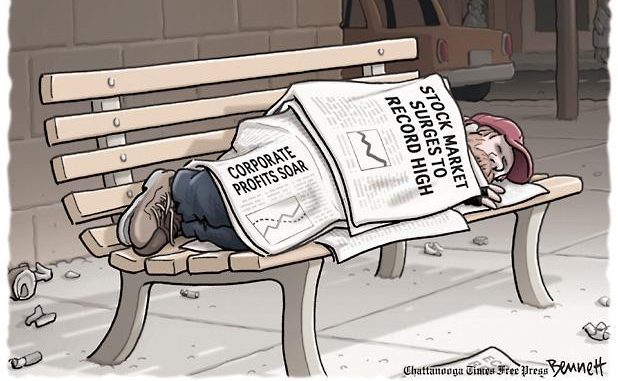
It has been ten years since the 2008 economic crisis – when tens of millions of workers in the U.S. lost their jobs and millions of families were kicked out of their homes. The government’s response to this crash is well known – they gave an estimated $12.8 trillion to bail out corporations and the very financial institutions that helped cause this crisis while giving nothing to the millions of working families that suffered from it. And their strategy, of supporting the banks and corporations at the expense of the workers, has set the tone for the so-called recovery that has followed.
Democrats and Republicans alike continue to claim that the U.S. economy has fully recovered from the 2008 crisis. And if we only look at official statistics, we can find a bit of truth in their claims. It is true that banks and corporations, and the richest of the rich are doing very well. In 2008, the richest 400 people in the U.S. had a total wealth of $1.5 trillion. Over the last ten years their wealth has doubled to about $3 trillion. Ten years ago, Amazon CEO, Jeff Bezos, was worth $8.7 billion but today his wealth has skyrocketed to $160 billion, making him the richest man in the world. Today the average CEO in the U.S. makes 312 times what most workers make — that means a typical CEO collects in one day about as much as the average worker makes in a whole year. In 2017, the richest eight people in the world owned more wealth than the poorest half of the world’s population.
But this so-called recovery hasn’t been anything more than a massive transfer of wealth to banks, corporations and their CEOs, paid for by the working class. Since 2008, as the wealth of the super rich doubled, the wealth of the average working-class household declined by about 20%. By the time a worker is thirty years old, they will have spent $93,000 on housing, about half of their entire income earned. It’s no surprise that today a record 50.8 million households, about 43%, can’t afford basic living expenses, including housing, food, transportation, child care, health care and a monthly cell phone bill. Since 1973, average worker productivity (the amount of goods and services produced per hour) has increased by 77 percent. But hourly pay has barely gone up. If the federal minimum wage increased to account for the rise in productivity, today it would be more than $20 an hour, not the poverty wage of $7.25.
Currently the official unemployment rate is at 3.9%. But these numbers don’t tell the real story. First, only 63% of the working-age population has a job today – the lowest it has been since 1990. The 3.9% figure excludes about 50 million part-time, temporary, and on call workers who are looking for full-time work but can’t find any. The majority of the jobs added since the 2008 crisis have been part-time jobs that don’t pay very much. Today, about 42 million workers — about 33% of the work force — earn less than $12 an hour, with no medical benefits offered. More than 40 percent of all workers know their work schedules just a week or less in advance.
In order to even get by workers have to take on massive amounts of debt. Today consumer debt is the highest amount ever recorded: $3.9 trillion, with $1.5 trillion as student loan debt. On average most workers owe more than 26 percent of their yearly income to debt. And if home mortgages are included, the total amount of household debt is about $13.3 trillion – the highest it has ever been. In other words, the amount of current household debt is about $618 billion higher than it was at its previous peak in 2008, just as the economy came crashing down.
Over the last ten years, in the U.S. and around the world, the working class has continued to pay for the 2008 crisis, and has increasingly produced wealth for an elite few who own the banks and corporations. And today the capitalists’ own economists warn us that another massive crisis is just around the corner. If it does break out, we will again see the capitalists try to pay for their recovery by squeezing more from us. The question is whether we will let them get away with it again. The working class does all the work of society and has no interest in suffering the consequences of a system of exploitation that survives on our labor.

